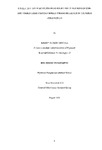Single cell gel electrophoresis-based investigations of UVR- and visible light-induced single strand breakage in cultured human cells
| dc.contributor.author | Kendall , Jeremy Fraser | |
| dc.contributor.other | Faculty of Health | en_US |
| dc.date.accessioned | 2013-10-29T12:55:29Z | |
| dc.date.available | 2013-10-29T12:55:29Z | |
| dc.date.issued | 1999 | |
| dc.identifier | NOT AVAILABLE | en_US |
| dc.identifier.uri | http://hdl.handle.net/10026.1/2448 | |
| dc.description | Merged with duplicate record 10026.1/627 on 27.02.2017 by CS (TIS) | |
| dc.description | Merged with duplicate record 10026.1/627 Submitted by Collection Services (collectionservices@plymouth.ac.uk) on 2011-09-23T10:53:04Z No. of bitstreams: 1 300874.pdf: 34357514 bytes, checksum: ba348bb40e7ab7a3d9575bd4d8319acf (MD5) Approved for entry into archive by Collection Services(collectionservices@plymouth.ac.uk) on 2011-09-23T10:53:15Z (GMT) No. of bitstreams: 1 300874.pdf: 34357514 bytes, checksum: ba348bb40e7ab7a3d9575bd4d8319acf (MD5) Made available in DSpace on 2011-09-23T10:53:15Z (GMT). No. of bitstreams: 1 300874.pdf: 34357514 bytes, checksum: ba348bb40e7ab7a3d9575bd4d8319acf (MD5) Previous issue date: 1999 | |
| dc.description.abstract |
Single strand breaks induced by very low fluence UVR (20 µW cmˉ² , 310 nm) and visible light (70 µW cmˉ² , 405 nm) and higher fluence unfiltered xenon arc lamp radiation (3 mW cmˉ² ) were measured by single cell gel electrophoresis. The normal responses of 6 cell lines to the low fluence radiation show a peak in single strand breaks after approximately 2 minutes, after which time the single strand breakage returns to background levels despite continued irradiation. This was not observed with the higher fluence irradiation. The repair of these single strand breaks was observed to be complete within 4 minutes after both high and low fluence irradiation. The dose responses were modulated by beta-carotene and o-phenanthroline; these molecules appeared to have both photosensitising and photoprotective properties, in the cells tested at least. Inorganic arsenic (V) was observed to inhibit single strand break repair and the religation of repair-related excised lesions. Arsenic-induced crosslinking and the excision of the crosslinked lesions were observed. The Area Moment, a new parameter for the image analysis of these low dose phenomena based on the measurement of the Comet Area and DNA migration, is proposed. The Area Moment displayed a higher level of sensitivity to the dose responses. Lower variance in Area Moment data enabled statistical significance (p < 0.05, t-test) to be attained where existing parameters returned only borderline significance at best. | en_US |
| dc.description.sponsorship | Cornwall Skin Cancer Research Group | en_US |
| dc.language.iso | en | en_US |
| dc.publisher | University of Plymouth | en_US |
| dc.title | Single cell gel electrophoresis-based investigations of UVR- and visible light-induced single strand breakage in cultured human cells | en_US |
| dc.type | Thesis | |
| plymouth.version | Full version | en_US |
| dc.identifier.doi | http://dx.doi.org/10.24382/3566 |
Files in this item
This item appears in the following Collection(s)
-
01 Research Theses Main Collection
Research Theses Main


